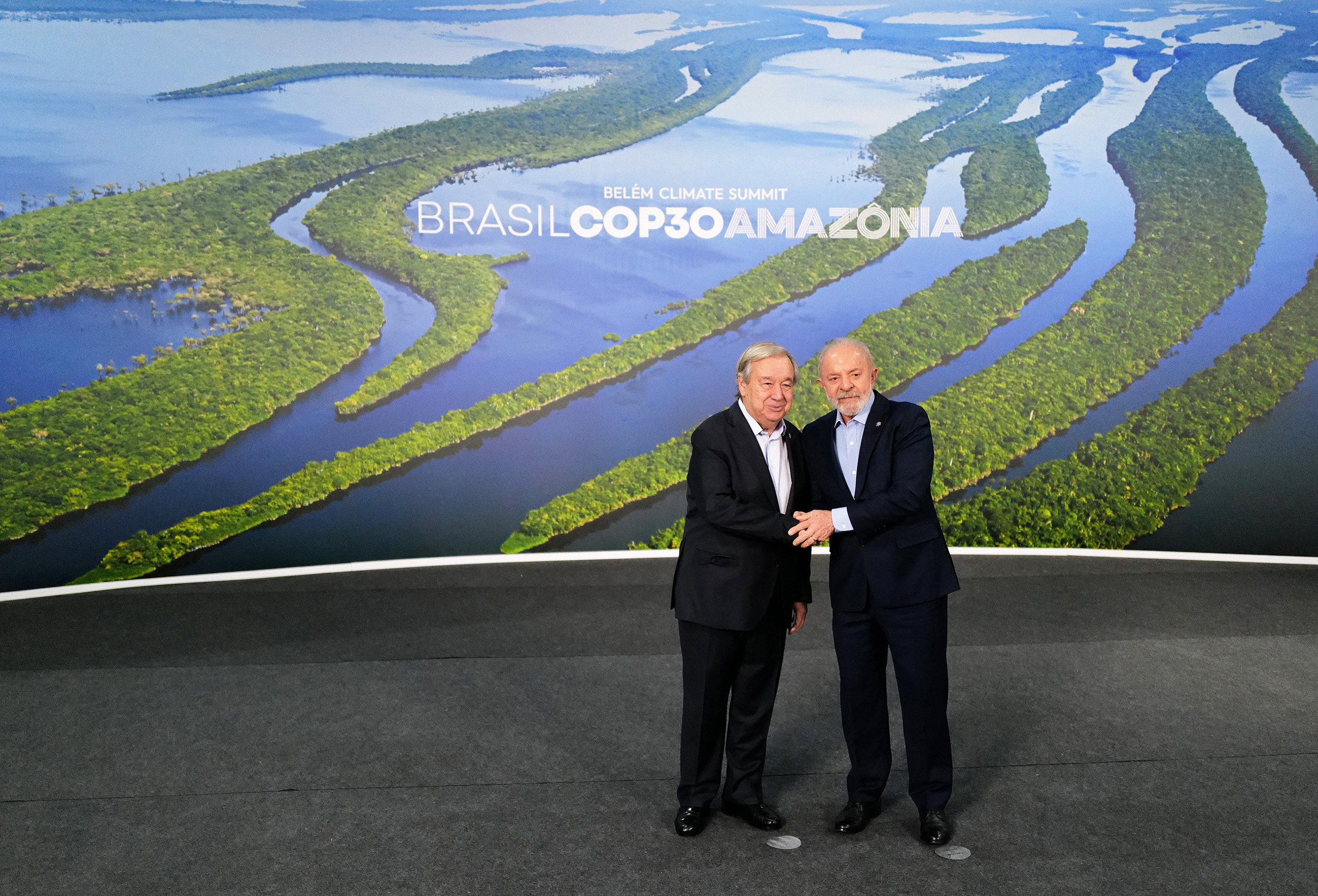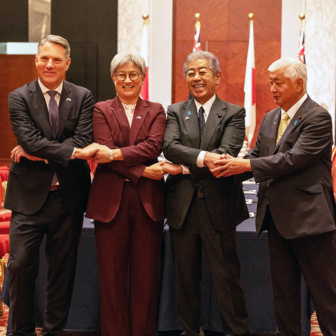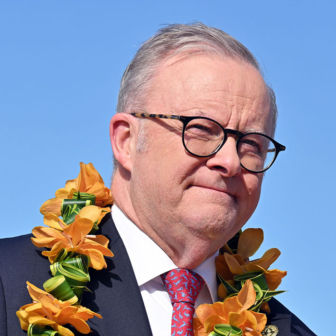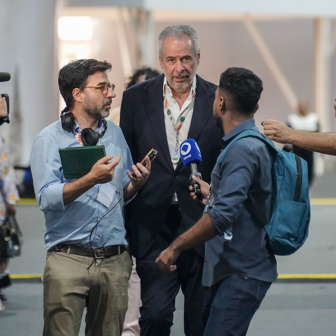Delegates and other participants arriving in the northeastern Brazilian port of Belém for the UN’s COP30 climate conference have been greeted by suitably forest-themed posters declaring the city “the capital of the Amazon.” They might therefore be forgiven for thinking that the waterway they glimpsed from the plane dramatically winding through the trees is the River Amazon, and that Belém sits at its mouth.
Sadly, they would be wrong. About 400 kilometres west of here the Amazon completes its nearly 7000 kilometre journey from the high Andes across northern South America by splitting into multiple smaller rivers. Belém sits close to the end of the southernmost of these, the Pará, where it meets the even smaller Rio Guamá coming in the other direction.
Never mind, the Amazon rainforest is very close, and the intrepid can take a five-day cruise upriver to the larger city of Manaus, capital of the state of Amazonas, which really is in the heart of the rainforest.
Belém, capital of Pará, was not everyone’s choice to host COP30. Not merely because it is far away (three and a half hours by plane) from Brazil’s main population centres (and airports) Rio de Janeiro and São Paulo, but because, though around two and half million people live in its wider metropolitan area, it doesn’t have nearly enough hotel rooms to accommodate the 50,000+ people who nowadays attend COPs. Country delegations and business representatives have complained they could find nowhere to stay, or that prices have been hiked to unaffordable levels. In the end the authorities managed to hire some cruise ships for the official delegations and enterprising entrepreneurs converted old shipping containers into windowless pods for the NGOs. Anyone with a half-decent apartment has rented it out and left town.
The Brazilian government claims it chose Belém to draw attention to the climatic threat to the whole world posed by the Amazon’s continued (though now slowing) deforestation. Locals will tell you that the governor of Pará, Helder Barbalho, is an important Workers’ Party player and a possible successor to Brazilian president Luiz Inácio Lula da Silva, and the COP venue the result of a private political deal.
Whatever the truth (and both could be true), Belém is an appropriate host city. It is not a bad thing for the numbers at COPs to be limited — two years ago Dubai’s COP28 attracted over 100,000 attendees — and many would say that if the hotel price mechanism is the way to do it, so be it.
Belém is typical of many cities in the developing world. At its centre stands its colonial legacy: an old town of charming seventeenth-century Portuguese buildings and two beautiful churches, the Basilica of Our Lady of Nazareth of Exile and Our Lady of Grace Cathedral. It has a traditional Catholic culture, which every October is celebrated in the five-hour procession of the “Círio of Nazaré” (otherwise known as the “Christmas of the Amazon”) in which thousands of local people follow a statue of the Virgin Mary being carried through the streets. But its population is multiracial: mainly descendants of the Portuguese, enslaved Africans and indigenous forest peoples, and their many mixed offspring.
Belém (Portugese for Bethlehem) became rich as the centre of the sugar trade, a product of Brazil’s vast slave plantations. Later it shifted to the export of rubber, and now of aluminium, iron ore and timber. As its airport posters indicate, it is trying to diversify into tourism, while at the same time coping with an urban expansion that puts pressure on its transport systems, air quality and poverty levels. It is in growing cities like this all over the world that we will discover whether net zero goals are indeed compatible with equitable economic development, and whether human societies can genuinely adapt to the climate change that is now inevitable.
Before COP30 formally begins on Monday, President Lula invited the world’s leaders to a summit this week to recommit to action on climate change. Acutely aware that Donald Trump is leading the counter-movement, both to expand the production and use of fossil fuels and to undermine the multilateral UN process, Lula and the UN secretary-general Antonio Guterrres wanted to get the rest of the world to stand up against him. They didn’t quite succeed.
In all, 144 countries sent ministers to the summit, a very impressive total. (The UN climate convention has 198 members.) But only around thirty were heads of government, and perhaps another thirty deputy heads. Donald Trump stayed away, of course, but so did the leaders of China, India and Indonesia, all countries with large and still rising emissions.
Perhaps surprisingly, since Australia is bidding to host next year’s COP31, so did Anthony Albanese. Luckily for him, President Erdogan of Turkey, Australia’s rival for the privilege, was also a no-show. “Perhaps they cut a deal,” said one wag. British prime minister Sir Keir Starmer came, left after one day, and failed to bring any media with him. Facing criticism at home that Labour’s climate policies are worsening the cost-of-living crisis (and that Starmer himself spends too much time overseas), one commentator observed acidly that “they obviously didn’t want the British public to know he’d been here.”
The summit itself was a slightly underwhelming event. President Lula’s main national objective was to get other countries to support his “Tropical Forest Forever Facility,” or TFFF, a bold plan to create a US$125 billion endowment fund to support countries (such as Brazil) committing to halt deforestation. The aim is to get governments, the private sector and philanthropies to invest in the fund, which in turn will invest in high-growth stocks around the world. The profits will be shared between the fund’s investors and countries that can show they are halting deforestation.
Having put US$1bn of Brazil’s own money into the fund, Lula will have been delighted he secured support from several other donors. The TFFF was endorsed by fifty-three countries, including all the major rainforest ones, and initial contributions now total US$5.5 billion of the core $25 billion goal, including $3 billion from Norway, $1 billion from Indonesia, $500 million from France, an as-yet-unspecified commitment from Germany and smaller sums from Portugal, the Netherlands and others.
Other sessions of the summit discussed how to combine poverty and hunger reduction with environmental sustainability — this is Lula’s overriding obsession — along with the clean energy transition and overall global emissions reduction. But Brazil did not seek agreement on a summit communique and didn’t issue one at the end.
Much to other countries’ surprise, and in some cases dismay, Brazil merely published a series of statements on the issues discussed, some signed by groups of participating countries, others just by Brazil. Apart from the TFFF, the statements included a “Belém Declaration on Fighting Environmental Racism,” a “Call to Action on Integrated Fire Management and Wildfire Resilience” and a “Belém Declaration on Hunger, Poverty and Human-Centered Climate Action.” President Lula did issue a general “Call of Belém for the Climate” asking other countries to step up their efforts, but it was in his name only.
So Lula and Guterres failed to secure a clear public statement from those 144 countries that — unlike Trump — they still believe in climate science, still believe in multilateral cooperation, and still specifically believe in the Paris agreement and its temperature goals.
It isn’t clear why they didn’t seek such an agreed statement: whether they thought it was too logistically difficult to negotiate, that not everyone would sign, or simply that it wasn’t necessary. But several experienced diplomats and politicians here believe it was a missed opportunity to give the global media a very clear story: that the vast majority of the world remains committed to climate action, and that Trump is isolated. It is notable how little coverage the summit’s conclusions have had in the world’s main media outlets.
That story will now have to be provided by the COP itself. This year it has three main agenda items, two of which are not actually on the agenda at all.
First, it must deal with the global “emissions gap.” This is the difference between two emissions numbers. The first is the level of global emissions in 2035 that climate scientists say will be necessary to put the world on a path to the overall warming limits agreed in Paris: well below 2ºC compared with pre-industrial times, and ideally no more than 1.5ºC. The second is the sum total of emissions that countries project for 2035 in their new national climate plans, the so-called “Nationally Determined Contributions,” or NDCs. There is a large gap between them.
COP30 is one of the five-yearly moments when — as stipulated by the Paris agreement — all countries must submit a new NDC, stronger than the last. But not all countries have done so. By the end of October, the UN climate secretariat was forced to admit that fewer than a third, only sixty-four, had submitted new NDCs, and this was not enough to make credible projections of global emissions in the target year of 2035.
The UN Environment Programme was less shy. Its annual Emissions Gap Report projected that countries’ new plans, if fully implemented, will put the world on a projected path to 2.3–2.5°C of warming. This compares to 2.6–2.8°C based on previously announced policies: a small improvement, but not much, and inevitably reduced by the US’s current stance and policy reversals.
Does this keep alive the Paris goal of limiting warming to 1.5°C? To get onto a 1.5°C pathway, says UNEP, would require a further 55 per cent reduction in annual global emissions by 2035 compared with 2019 levels (35 per cent for a 2°C pathway). As it notes, the size of such cuts, the short time available to deliver them, and the challenging political climate, make 1.5°C almost certain to be exceeded within the next decade. But UNEP also points out that this doesn’t mean the goal should be abandoned. Global average temperatures were always likely to overshoot 1.5°C of warming, and would then need to be returned to that level by 2100 by serious (and as yet highly uncertain) investment in removing carbon from the atmosphere. This prospect, it says carefully, remains “within the realms of possibility — although doing so will be extremely challenging.”
You might have thought that the emissions gap would be the key item on the COP30 agenda — and most countries in the world would agree with you. But a powerful bloc, including China, India and Saudi Arabia, is insisting that there is no provision in the Paris agreement for a collective discussion of NDCs. They are called “Nationally Determined” for a reason. They argue (almost certainly correctly) that the system of “global goals but nationally chosen targets” was precisely the compromise that made the Paris agreement possible.
Most other countries think this is ridiculous. If a global climate conference can’t discuss the emissions gap, what is its point? So we can expect this argument to take up a lot of the opening day on Monday, when the conference agenda must be agreed before the proceedings proper get started. As the COP presidency, Brazil must remain studiedly neutral between country positions. But it will surely try to steer this issue towards the climate ministers when they arrive for the second week (the first is just officials). And they will probably succeed, since almost all the ministers will want to discuss the emissions gap and what can be done about it.
Some ideas exist already. President Lula has himself proposed that the UN should produce a “roadmap for the transition away from fossil fuels.” This is a bit of a gauntlet thrown down to Saudi Arabia and Russia, who since 2023 have blocked all international forums from using this phrase, even though it was agreed at COP28 and is officially the world’s aim. “This issue is going to make the COP quite spicy,” grinned one delegate.
Also not on the official agenda is a second report, the “Baku to Belém Roadmap to $1.3 trillion.” This is the document mandated by last year’s COP29 in Baku to get itself out of a tricky negotiating hole. The Paris agreement said the world had to agree a “New Collective Quantified Goal,” or NCQG, for climate finance: that is, the sums of money that should be provided to developing countries to help them reduce emissions and adapt to climate impacts. Last year, at COP29, the developed countries, who have the leading responsibility, said they would provide at least $300 billion annually by 2035 from public resources (including some mobilised from the private sector). But this was far less than the developing countries wanted, and that expert analysis suggested they needed. So the COP also agreed an aspirational goal of some $1.3 trillion a year in total financial flows to developing countries by 2035, without assigning anyone the responsibility to make sure it happened. Instead they asked the two COP presidencies Azerbaijan and Brazil, to produce a “Roadmap” showing how the $1.3 trillion could be raised, and to report it to COP30.
The Roadmap was published on Wednesday. It is a comprehensive examination of all the different sources of public and private money that could conceivably flow to developing countries over the next decade (a total sum, it notes, many times larger than $1.3 trillion) and the different fields in which it would need to be invested. It makes a strong case that emerging and developing countries will get stronger growth through a low-carbon and climate-resilient economic development path than by continuing to rely on fossil fuels. It sets out nearly fifty measures which, were they taken by governments and financial institutions (both public and private), would start to get serious monies flowing.
But this report, too, is not due to be discussed by the COP. Because it was inserted into the final agreed text in Baku by ministers very late in the negotiations, it was neither fully understood nor accepted by the official negotiators. As it has been produced in a highly unorthodox way by two COP presidencies, rather than negotiated by all 198 UN parties (though Brazil and Azerbaijan extensively consulted countries and others), some are saying that the most that can happen at COP will be for the report to be “noted.”
Again, though, this view seems unlikely to prevail. Ministers from developing countries are desperate to ensure that there is more money available for climate-positive development over the coming decade. They will want to discuss the Roadmap and how the measures in it can be implemented. Expect this, too, to happen in the second week.
The third key issue for the COP is on the agenda. That’s an agreement on the “Global Goal on Adaptation,” another requirement the Paris agreement put on the future negotiating table. With their uncanny ability to justify their own existence, country negotiators have been talking about what such a goal might look like for eight years, yet have still not reached a conclusion. But there is quiet confidence in Belém that Brazil will apply some gentle (or maybe not so gentle) pressure to get at least one unequivocal win out of its conference.
There’s also talk of another triumph the Brazilians might pull off: ending the conference on time, at 6pm on Friday 21 November. COPs never finish at the timetabled hour: even though they have two weeks to come to agreement, the negotiators always leave at least one issue to the very end, and then beyond. Recent COPs have continued well into the Saturday and even Sunday before dramatic last-minute resolutions. With much less on the negotiating table this year, observers are wondering whether Brazil can do the unthinkable. Not getting the world to act faster on climate change, but to stop talking about it at the scheduled time. •




